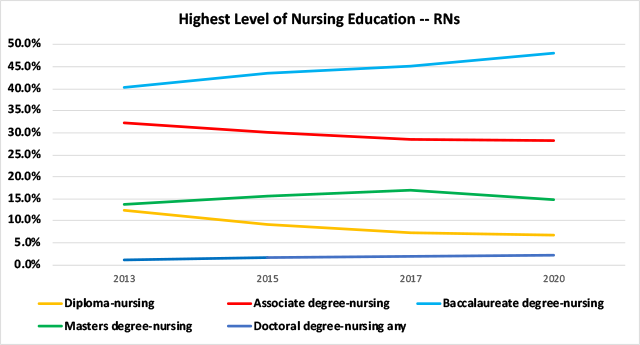The Future of Nursing: 10 Key Health Care Statistics in 2022

The COVID-19 pandemic has highlighted just how valuable nurses are both to our individual health and the health of our communities. The pandemic will have lasting effects on the landscape of health care going forward, and in many cases nurses are leading the charge on meaningful fixes to systemic problems.
The public has become much more aware of how vital the nursing profession is to our health as a society, and how demands on nurses affect how they deliver care. Let’s take a look at some key health care statistics and trends to help us understand the future of nursing.
1. Demand is increasing for qualified nurses
In the United States, nurses form the largest group of health care providers. Data from the U.S. Bureau of Labor Statistics (BLS) shows there are more than 3 three million registered nurses in the country. BLS projections for the profession show that nurses can look forward to a 9% job growth rate for the years between 2020 and 2030, which is about average for all professions that the BLS tracks. This means that based on the BLS data, there will be about 194,500 job openings per year, on average, for RNs in that same 10-year period.
Some of the job openings are related to natural turnover as nurses in the baby boomer cohort leave the profession. In fact, one study predicted that as many as 70,000 registered nurses (RNs) would be retiring each year until 2030. Other RNs will be leaving for new positions or getting out of the workforce altogether.
2. There is a national nursing shortage
In the U.S. there is an overriding concern about a national nursing shortage.
For more than a decade, studies have predicted that there would not be enough nurses to meet patient demand. One factor contributing to the shortage, according to the American Association of Colleges of Nursing (AACN), is an insufficient number of nurse graduates—particularly those with bachelor’s or master’s degrees—to replace the RNs leaving the workforce. The number of nursing graduates has been limited by a lack of faculty in nursing schools. The AACN estimates that more than 80,000 applicants were unable to enroll in nursing programs because there aren’t enough nursing faculty to accommodate all of them. Some nursing schools are addressing the limited availability of student slots by offering fully accredited online programs.
3. Patient population demographics point to the need for even more nurses
Another factor that analysts are concerned about is the rising numbers of senior patients who need more of the health care services that nurses and others provide. The baby boomers are well into their retirement years, and according to Census Bureau projections, for the first time, the number of people over 65 will outnumber children age 13 and younger by the year 2025.
Boomers are going into their senior years with multiple comorbidities that call for nursing management. Dr. Joanne Lynn, a legislative aide on health and aging policy for a member of Congress, shared the opinion that “we are going to have to deal with the costs, workforce and service delivery arrangements for large numbers of elders living for at least a year or two with serious disabilities.”
Quality nursing will be needed for the next population groups as well. Millennials are already entering middle age and are less healthy than the Gen Xers (the cohort just ahead of the millennials), says a report from the Blue Cross and Blue Shield Association.

4. COVID-19 is affecting nurses’ career plans
For nurses, getting ready for increased numbers of older patients was comparable to preparing for a far-off storm, while COVID-19 hit U.S. health care like an earthquake—sudden, destructive and without warning.
Nurses had to deliver care in unfamiliar conditions, with an overwhelming number of patients, all while facing a pathogen that could endanger them as well. Luckily, most nurses have decided to remain in nursing despite the threat of job burnout brought on by unprecedented workload and emotional stress.
According to the Nursing Trends and Salary Survey results reported in November 2020, “85% of respondents say the pandemic hasn’t changed their career plans, 11% plan to change their job or specialty, and 2% plan to leave nursing.” But just six months later, a survey by McKinsey & Company reported that as many as 22% of nurses were considering leaving their current positions.
5. Nurse salaries are good and, in some cases, are getting higher
The BLS shows the median annual salary for registered nurses as $75,330. Salaries, of course, are dependent on location, experience and any additional certifications an RN might hold. But the pandemic has a part to play in nurse salaries, too.
To retain staff nurses, some hospitals are offering retention bonuses and boosting hourly pay rates. Or they are giving bonuses to nurses who accept assignments in areas of high need. Agencies that place travel nurses are offering new hires up to $150 an hour and signing bonuses approaching $20,000. For nurses who say they are more likely to remain nurses because of COVID-19, favorable compensation and economic stability were the strongest drivers of their decision.
6. Nurse demographics and educational attainment
There are many positive trends in the nursing profession. Changes in nurse demographics indicate that the field is becoming more diverse in terms of ethnicity and gender. And a greater percentage of people are qualifying for licensure as an RN with a bachelor’s degree than before. The 2020 National Nursing Workforce study included several interesting statistics:
- The median age of nurses is 52.
- The percentages of male nurses (9.4%) and nurses from minority backgrounds (19.2%) continue to rise.
- The percentage of nurses with a Bachelor of Science in Nursing (BSN) as their entry to licensure is increasing.

Source: National Nursing Workforce Study
7. Nursing is a well-regarded profession
Nurses are held in high esteem by the American public according to the annual survey of honesty and ethics conducted by Gallup. In fact, nurses ranked No. 1 for honesty and ethics for the 20th year in a row.
Registered nurses aren’t the only ones who are valued, however. Nurse practitioners consistently get high rankings from patients who appreciate their patient-centered focus. In addition, nurse practitioner is ranked as the No. 1 job in health care by U.S. News & World Report.
8. Nurses are key to expanding health equity in the United States
When evaluating health care and equity in the U.S., experts believe nurses have a pivotal role to play in addressing multiple needs in the communities they serve. In their report, “The Future of Nursing 2020–2030,” a committee put together by the National Academies of Medicine made several recommendations for improving health equity in the nation. By expanding the ranks of nurses from diverse communities, supporting community and public health nursing, and fostering leadership and advocacy among nurses, nurses can further promote health and well-being.
9. Technology will play a larger role in nurse education
Of course, as nurses move toward the future of care, technology will play a growing role—beginning with the instructional environment. A survey of nursing school deans and faculty conducted by Wolters Kluwer and the National League for Nursing showed that educators are interested in making technological learning solutions available to their students, whether they are in the classroom or enrolled online.
Some of the new platforms under discussion include:
- Virtual simulation, virtual reality and augmented reality for clinical education
- Adaptive quizzing and secure exam delivery
- Learning management systems
10. Technology will assist nurses in care delivery
Different types of assistive technology are under development right now for use in hospitals and other care settings. Nurses may look favorably on robots that can shuttle equipment, medications or specimens from one spot to another so the nurse can spend valuable time with patients. A robot has even been developed that uses broad-spectrum ultraviolet light to disinfect rooms.
Nurses have already moved into digital care delivery with the use of telehealth services (another technology that got a boost because of the pandemic). Being able to video conference with patients to monitor their conditions has proven to be a great boon to those with smart devices and good internet connections.
Some nurses who are new to these types of technologies may see these tools as being too intrusive—that they put too much distance between nurse and patient. But others may be able to see the benefits they offer and strike the right balance between tech and the human touch.
Let Elmhurst University set you on your path to a future in nursing
If you are interested in becoming a registered nurse, look into the highly-regarded nursing programs that Elmhurst University has to offer. There are two distance accelerated nursing programs to choose from, both of which are designed for those who already hold a bachelor’s degree in a non-nursing discipline:
- Online Accelerated Bachelor of Science in Nursing (ABSN) Graduates earn their BSN and can sit for the NCLEX-RN licensing exam in just 16 months.
- Online Master’s Entry to Nursing Practice (MENP) Graduates earn a Master of Science in Nursing degree in 20 months, can sit for the NCLEX-RN and enter nursing practice qualified to advance into leadership roles.
Each program has been designed to provide a thorough, evidence-based nursing education via online instruction, clinical and lab hours, and on-campus residencies.
Learn more about our online nursing entry programs.

